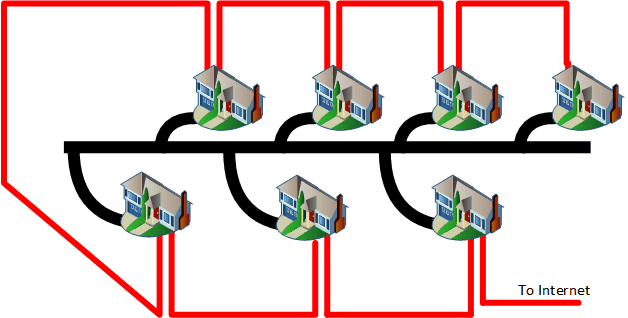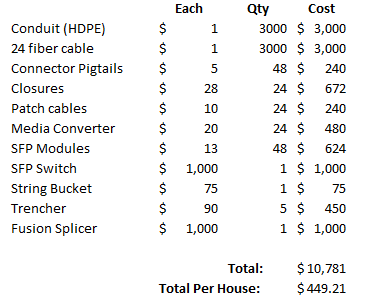
Quick & Dirty Design for Small HOA
If you have a small group of houses, say 20 along a street, then installing a fiber network need not be complex. At all.
Look at this diagram. If you can get right of ways, the easiest path to run fiber to each house is to come in from the backyards. This way you generally don't have to worry about crossing hardscape like driveways. So in this diagram, the red lines shows the underground conduit paths that daisy chain from backyard to backyard:

To actually dig the trenches, use a trencher like this one:

Which is available for rent from Home Depot for around $90/day.
Use a coil of HDPE pipe brought up to about 4' from the ground at each house. You'll have two conduit pipes poking up at the same place at each house so that you can fit each conduit into a simple splice closure like this one:

Which can be bought here for about $30. The HDPE conduit will cost about $1/ft in 500' rolls (here's a supplier).
Once you've laid and installed all your conduit and splice closure boxes, you're ready to pull fiber. For a small community, just buy a 24, 36 or 48 count fiber cable. A 24 strand fiber cable also costs about $1/foot (for instance available here).
Use your favorite fiber pulling technique to pull the fiber into the conduit. I like to use a shop vac and a string fish bucket (like this one). Rip a thin plastic bag and make a tiny "parachute" tied onto the end of the string. At one of the conduit, suck the air out using the shop vac, while at the other end feed the parachute/string into the conduit. It should rip along very quickly until it gets sucked into the shop vac. You now have a pull string for the fiber.
For each fiber connection back to the central location, you want to have a continuous fiber cable. So if your first conduit is 100' long and all the conduit together is 2500', for your first pull, you'll want to pull all 2500' of fiber through the 100' first conduit, laying it in a figure 8 pattern on the ground to make it easy to pull into the next conduit leg. Leave about 6' of fiber looped into each splice closure at each house. Remember to treat fiber with care, never kink it or bend it too tightly.
Once all the fiber is pulled, you can terminate each fiber at each house. The idea is that each house will have an individual fiber strand going back to the central office location. The strands will be packaged in buffer tubes of 12 fibers each. Buffer tubes are color coded and each fiber strand within the fiber tubes are also color coded. Make a map showing which house gets which fiber color from which buffer tube.
At each house, you'll want to remove the outer jacket of the 24 count fiber cable WITHOUT cutting any fibers. There are tools and techniques to do this, which you'll have to research and/or ask your fiber supplier. Watch YouTube videos. Practice. You want to loop the 6' of now exposed buffer tubes around the pegs. isolate the correct buffer tube and slice that one open, exposing the individual fibers. Again, isolate the single fiber you want. Now you can finally cut that fiber such that you have about 6' of fiber on the side going towards the central office. The other side of the fiber strand is abandoned. Attach a factory connector with a pigtail to the central office side of the fiber.
While there are field press on connectors available, really the best way to install a connector is to use a fusion splicer. You can buy a cheap one for around $1,000 or rent a good one for around $1,000 a week. That's why you want about 6' of extra fiber length, so that it can reach a small table abutting the house where you'll have your fusion splicer.

So each house's splice closure will now have a fiber plugged into a plug bulkhead inside the splice closure. To get inside the house, just buy a bunch of standard length both end pre-terminated single mode patch cables.
OK, so what equipment does all this plug into? This is far too small an install for GPON, the extra complexity isn't worth it. The simplest network is to do what Michaelston-y-Fedw did, and use Gigabit fiber Ethernet from each house to a central switch. In the central location, buy a switch that has 24 or so SFP ports, like this:

Here's the product info. Each fiber strand from the 24 count cable will be spliced on a connector in the central office/location, and then plugged into a 1000Base-BX SFP module plugged into a SFP slot in the switch. Such an SFP module looks like this:

And here's the product info for that SFP module. Note that these SFP modules must be bought in A and B pairs. You use the A version, for instance, in the central office switch, while all the B versions go into each house. OK, so that's the central office (I'm assuming your incoming Internet connection plugs into the switch using a Gigabit Ethernet connection from wherever you are getting your Internet from).
In the house, you have your fiber patch cable which then plugs into the SFP module which plugs into this little powered media converter (which has both an SFP slot and an Ethernet port):

Product info page here. You then plug the media converter's Ethernet port into your favorite home router.
That's it. Depending on how exactly your upstream ISP provisions your link, you may have to additionally buy a few hundred dollar router to go into the central office/location. Assuming labor cost is free for such a community project, costs look like this for a 24 house network that spans 3,000 feet of conduit/fiber:
